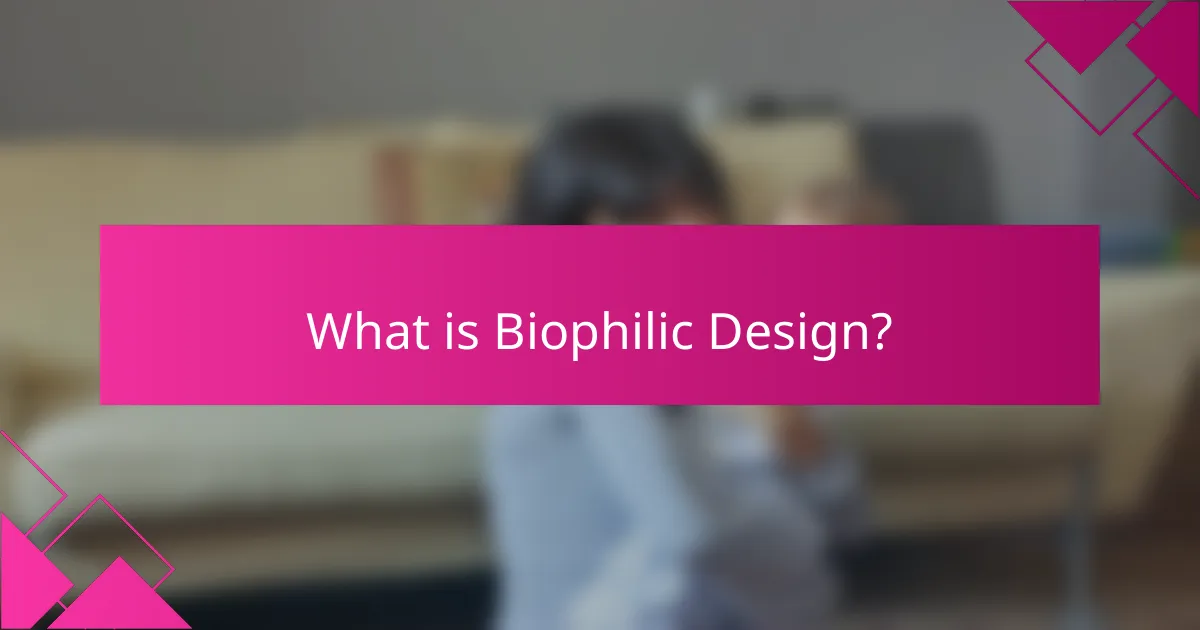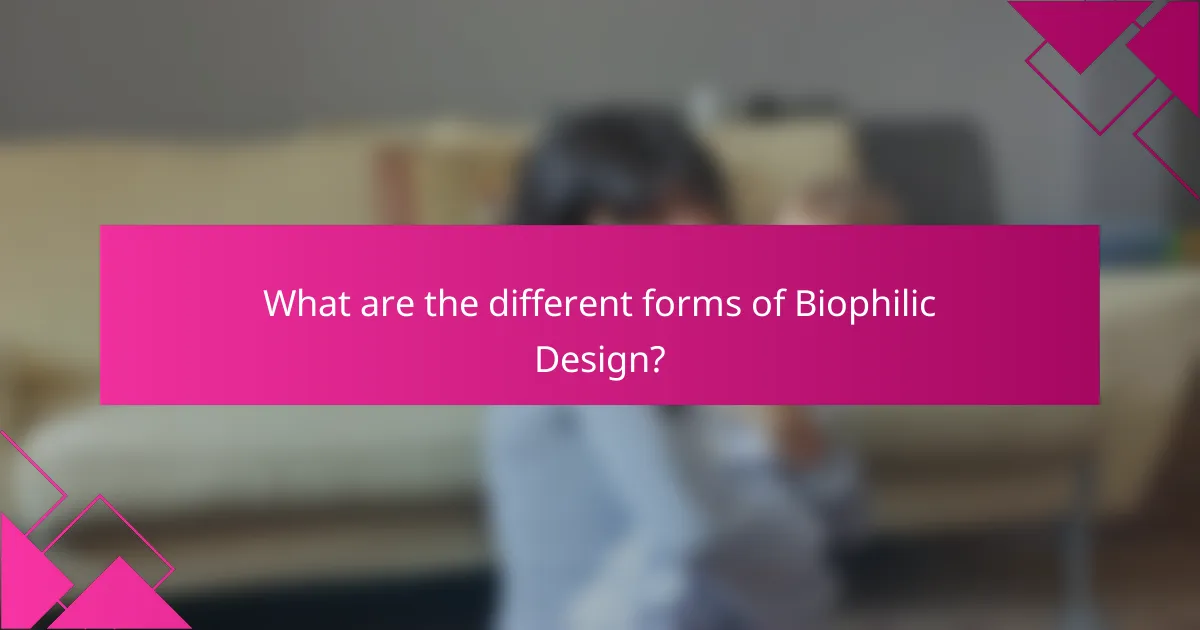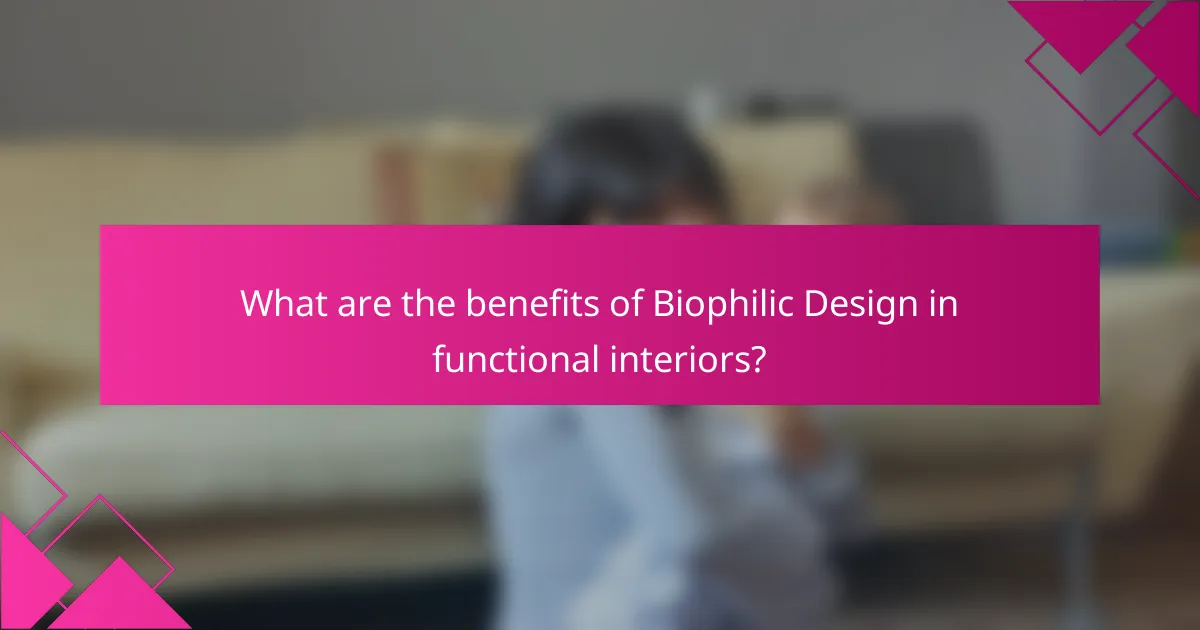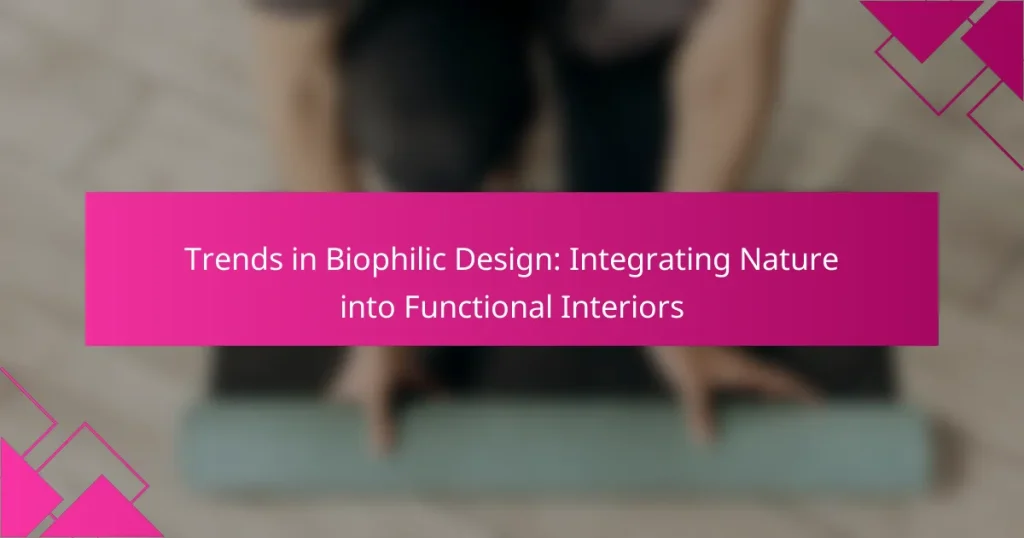Biophilic design is an architectural and interior design approach that integrates natural elements into built environments to foster a connection between people and nature. This design philosophy enhances well-being and productivity by incorporating features such as natural light, plants, and water elements, which have been shown to reduce stress and improve mood. The article explores various forms of biophilic design, including direct, indirect, and spatial connections to nature, and discusses their impact on creativity and cognitive function. It highlights the benefits of biophilic design in creating healthier, more sustainable living and working spaces, ultimately leading to increased occupant satisfaction and comfort.

What is Biophilic Design?
Biophilic design is an approach that seeks to connect people with nature in built environments. It incorporates natural elements into architectural and interior design. This design philosophy enhances well-being and productivity. Research indicates that exposure to nature reduces stress and improves mood. Elements like natural light, plants, and water features are commonly used. Studies show that biophilic design can increase creativity and cognitive function. The integration of these elements creates spaces that promote health and sustainability.
How does Biophilic Design integrate nature into interiors?
Biophilic design integrates nature into interiors by incorporating natural elements and materials. This approach enhances the connection between occupants and the natural environment. It often includes features like indoor plants, natural light, and water elements. For example, using large windows maximizes daylight and views of the outdoors. Additionally, natural materials such as wood and stone create a tactile connection to nature. Research indicates that these elements can improve well-being and productivity. A study published in the Journal of Environmental Psychology found that exposure to nature can reduce stress levels. Therefore, biophilic design effectively enhances indoor environments by fostering a sense of nature.
What are the key principles of Biophilic Design?
The key principles of Biophilic Design include the integration of natural elements into built environments. These principles aim to enhance the connection between people and nature. They focus on providing access to natural light, incorporating vegetation, and using natural materials. Patterns and textures that mimic nature are also essential. Furthermore, views of nature from interior spaces promote well-being. This design approach emphasizes the importance of airflow and water features. Research shows that environments designed with these principles can reduce stress and improve productivity. Studies indicate that exposure to nature can enhance cognitive function and emotional health.
How does Biophilic Design influence human well-being?
Biophilic design significantly enhances human well-being by fostering a connection to nature. This design approach incorporates natural elements into built environments. Research indicates that exposure to nature reduces stress levels. A study by Kaplan and Kaplan found that natural views can improve attention restoration. Additionally, biophilic design increases feelings of happiness and comfort. Natural light and greenery in spaces promote better mental health. According to a report from the World Green Building Council, such environments can enhance productivity by up to 15%. Overall, biophilic design creates healthier, more satisfying living and working spaces.
Why is Biophilic Design trending in modern architecture?
Biophilic design is trending in modern architecture due to its focus on enhancing human well-being through nature integration. This design approach promotes natural light, greenery, and organic materials. Studies show that biophilic environments reduce stress and improve productivity. Research from the University of Exeter found that workplaces with biophilic elements increased employee well-being by 15%. Additionally, urbanization has created a need for reconnecting with nature in built environments. The growing awareness of environmental sustainability further drives this trend. Architects are increasingly prioritizing designs that foster a connection to the natural world.
What societal factors contribute to the rise of Biophilic Design?
The rise of Biophilic Design is influenced by several societal factors. Increased urbanization leads to a disconnection from nature. This disconnection causes a demand for natural elements in living and working spaces. Health and wellness trends emphasize the importance of mental well-being. Studies show that exposure to nature reduces stress and enhances productivity. Environmental awareness drives the desire for sustainable design practices. The COVID-19 pandemic has heightened the need for healthier indoor environments. As a result, Biophilic Design has gained popularity in architecture and interior design.
How does technology facilitate Biophilic Design in interiors?
Technology facilitates Biophilic Design in interiors by enhancing the connection between occupants and nature. Smart lighting systems mimic natural daylight patterns. This helps regulate circadian rhythms and improves well-being. Virtual reality tools allow designers to visualize nature-inspired spaces before implementation. Biophilic design apps provide insights on integrating natural elements effectively. Automated climate control systems create comfortable environments that mimic natural conditions. Green walls and living plant systems can be monitored through technology for optimal health. Research shows that these technological integrations increase productivity and reduce stress. Overall, technology plays a crucial role in bringing nature indoors effectively.

What are the different forms of Biophilic Design?
The different forms of Biophilic Design include direct, indirect, and spatial connections to nature. Direct connections involve the use of natural elements like plants, water features, and sunlight. Indirect connections utilize natural materials, colors, and patterns that mimic nature. Spatial connections focus on the layout and organization of spaces to enhance the experience of nature. Each form aims to improve well-being and productivity by fostering a connection to the natural environment. Studies show that incorporating these elements can lead to reduced stress and increased creativity in occupants.
How can natural elements be incorporated into interior spaces?
Natural elements can be incorporated into interior spaces through various design strategies. One effective method is using natural materials such as wood, stone, and bamboo. These materials create a warm and inviting atmosphere. Incorporating plants adds greenery and improves air quality. Studies show that indoor plants can reduce stress and enhance well-being. Natural light can also be maximized through larger windows or skylights. This connection to the outdoors promotes a sense of tranquility. Water features, like fountains, can introduce soothing sounds and humidity. Additionally, using earthy color palettes can evoke a natural feel. These strategies collectively enhance the aesthetic and psychological benefits of interior spaces.
What types of plants are most effective in Biophilic Design?
Foliage plants are most effective in Biophilic Design. These plants enhance indoor environments by improving air quality and providing visual comfort. Common examples include peace lilies, snake plants, and pothos. They thrive in various light conditions and require minimal maintenance. Research shows that incorporating greenery can reduce stress and increase productivity. A study by Kaplan and Kaplan (1989) indicates that nature elements positively influence human well-being. Additionally, plants like ferns and spider plants contribute to humidity regulation. Their presence can create a calming atmosphere in work and living spaces.
How do water features enhance Biophilic Design?
Water features enhance Biophilic Design by creating a sensory connection to nature. They provide visual appeal through the movement and reflection of water. This interaction with water can reduce stress and promote relaxation. Studies show that the sound of flowing water can improve focus and cognitive function. Additionally, water features can increase humidity, which benefits indoor air quality. These elements contribute to a holistic environment that fosters well-being. Incorporating water features aligns with the principles of Biophilic Design by mimicking natural ecosystems. This integration encourages a deeper appreciation of nature within built environments.
What materials are commonly used in Biophilic Design?
Biophilic design commonly uses natural materials such as wood, stone, and plants. Wood provides warmth and texture, creating a connection to nature. Stone adds durability and a sense of grounding. Plants enhance air quality and bring life into spaces. Other materials include water features, which promote tranquility and relaxation. Natural textiles like cotton and wool offer comfort and sustainability. Glass is also utilized to maximize natural light and views of the outdoors. These materials collectively foster a sense of well-being and connection to the environment.
How do sustainable materials contribute to Biophilic Design?
Sustainable materials enhance Biophilic Design by fostering a connection between people and nature. These materials often mimic natural elements, promoting a sense of well-being. For example, wood, stone, and bamboo provide tactile and visual links to the outdoors. They also support environmental health by reducing carbon footprints. Sustainable materials are often sourced responsibly, minimizing ecological impact. Using recycled or reclaimed materials further reinforces this connection. Research shows that spaces using natural materials can improve mood and productivity. This aligns with Biophilic Design principles, emphasizing nature’s role in enhancing human experience.
What role does natural light play in Biophilic Design?
Natural light is essential in Biophilic Design as it enhances well-being and connects occupants to nature. This design approach emphasizes the integration of natural elements into built environments. Natural light improves mood, productivity, and overall health by regulating circadian rhythms. Studies show that exposure to daylight can reduce stress and increase focus. For instance, a study published in the Journal of Environmental Psychology found that natural light exposure significantly boosts cognitive function. Therefore, incorporating natural light is a fundamental aspect of creating spaces that foster a connection to the natural world.

What are the benefits of Biophilic Design in functional interiors?
Biophilic design enhances functional interiors by improving well-being and productivity. It incorporates natural elements to create a calming environment. Research shows that exposure to nature reduces stress levels. A study by Kaplan and Kaplan indicates that natural views can boost focus and creativity. Biophilic spaces often increase occupant satisfaction and comfort. This design approach can also improve air quality through the use of plants. Additionally, natural light in interiors promotes better mood and energy levels. Overall, biophilic design contributes to healthier and more productive living and working spaces.
How does Biophilic Design improve productivity in workspaces?
Biophilic design improves productivity in workspaces by enhancing employee well-being and focus. Incorporating natural elements, such as plants and natural light, creates a more inviting environment. Research shows that exposure to nature can reduce stress levels by up to 60%. A study published in the Journal of Environmental Psychology found that employees in biophilic-designed spaces reported a 15% increase in productivity. Additionally, natural light can improve mood and energy levels, leading to higher engagement. Overall, biophilic design fosters a healthier workplace that supports better performance and creativity.
What evidence supports the impact of Biophilic Design on mental health?
Biophilic Design positively impacts mental health by enhancing well-being and reducing stress. Research indicates that environments incorporating natural elements lead to lower anxiety levels. A study by Kaplan and Kaplan (1989) found that views of nature can significantly improve mood and cognitive function. Another research conducted by Ulrich (1991) demonstrated that patients with views of nature experienced faster recovery times in healthcare settings. Furthermore, a meta-analysis by Bratman et al. (2015) highlighted that interactions with natural environments can decrease feelings of depression. These findings collectively support the notion that Biophilic Design fosters mental health benefits through its integration of nature.
How can Biophilic Design enhance customer experience in retail environments?
Biophilic Design enhances customer experience in retail environments by creating a connection to nature. This design approach incorporates natural elements such as plants, water features, and natural light. Studies show that these elements can reduce stress and increase feelings of well-being. For instance, a research by the Human Spaces report found that workplaces with natural elements increased creativity by 15%. Additionally, biophilic elements can improve customer dwell time and satisfaction. A retail space that feels more inviting can lead to higher sales. Integrating nature in design not only attracts customers but also fosters a memorable shopping experience.
What challenges are associated with implementing Biophilic Design?
Implementing Biophilic Design faces several challenges. One major challenge is the high initial cost of integrating natural elements. This can deter clients and stakeholders from pursuing such designs. Another challenge is the need for specialized knowledge and skills. Designers must understand both biophilic principles and sustainable practices. Limited availability of suitable materials can also pose difficulties. Sourcing natural materials that meet design specifications may be challenging. Additionally, regulatory barriers may complicate the implementation process. Compliance with building codes and zoning laws can restrict design options. Lastly, there can be resistance to change from traditional design practices. Stakeholders may prefer conventional methods over innovative biophilic approaches.
How can designers overcome barriers to Biophilic Design?
Designers can overcome barriers to Biophilic Design by prioritizing education and collaboration. Knowledge of Biophilic principles enhances design strategies. Engaging stakeholders early fosters support for natural elements. Utilizing local materials connects spaces to their environment. Implementing flexible design solutions accommodates varying budgets. Research shows that integrating plants can improve air quality and well-being. Studies indicate that natural light boosts productivity and mood. By addressing these aspects, designers can effectively implement Biophilic Design.
What are common misconceptions about Biophilic Design?
Common misconceptions about Biophilic Design include the belief that it only involves adding plants to interiors. Biophilic Design is a broader concept that integrates natural elements, light, and materials into spaces. Another misconception is that it is purely aesthetic. Research shows that Biophilic Design enhances well-being and productivity, not just visual appeal. Some people think it is only relevant for residential spaces. In reality, Biophilic Design is applicable in commercial and public environments as well. Additionally, there is a belief that Biophilic Design is expensive. However, it can be implemented at various budget levels. Lastly, some assume it is a trend rather than a sustainable approach. Studies indicate that Biophilic Design is rooted in human biology and psychology, making it a timeless practice.
What are best practices for incorporating Biophilic Design?
Incorporating Biophilic Design involves integrating natural elements into built environments. Use natural light to enhance well-being and productivity. Incorporate plants and greenery to improve air quality and create a calming atmosphere. Utilize natural materials like wood, stone, and water features to evoke a sense of nature. Design spaces that offer views of nature, such as windows overlooking gardens or parks. Create open layouts that encourage airflow and connection to the outdoors. Implement color palettes inspired by nature to foster a sense of tranquility. Lastly, consider acoustic elements that mimic natural sounds to enhance the sensory experience. These practices have been shown to reduce stress and improve overall health in occupants.
How can individuals create Biophilic spaces in their homes?
Individuals can create biophilic spaces in their homes by incorporating natural elements into their interiors. This can be achieved by using plants as decor, which improves air quality and enhances mood. Natural light is essential; maximizing windows or using skylights can connect indoor spaces with the outdoors. Water features, such as small fountains, can add soothing sounds and promote relaxation. Natural materials, like wood and stone, can be used in furniture and flooring to bring a tactile connection to nature. Color palettes inspired by nature, such as greens and blues, can create a calming atmosphere. Views of nature from windows or through artwork can further enhance the connection to the environment. Research shows that biophilic design can reduce stress and improve well-being, making these changes beneficial for mental health.
What tips can professionals follow to ensure effective Biophilic Design?
Incorporating natural elements is essential for effective Biophilic Design. Professionals should use materials like wood, stone, and plants. These materials create a connection to nature. Additionally, maximizing natural light enhances the space’s ambiance. Integrating water features can also improve the sensory experience. Designing with views of nature promotes well-being. Using organic shapes and forms mimics natural landscapes. Lastly, incorporating greenery inside spaces improves air quality. These strategies have been shown to reduce stress and enhance productivity in various studies.
Biophilic design is a methodology that integrates natural elements into architectural and interior spaces to enhance human well-being, productivity, and sustainability. This article explores the principles of biophilic design, its impact on mental health, and the societal factors driving its popularity in modern architecture. Key topics include the incorporation of natural light, plants, and water features, as well as the challenges and misconceptions associated with implementing biophilic design. Additionally, it provides best practices for creating biophilic environments in both residential and commercial settings, emphasizing the importance of connecting occupants with nature to foster healthier living and working spaces.


